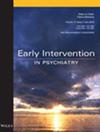Early Detection of Psychosis in Eating Disorders: Unnecessary or a Useful Addition?
Abstract
Aim
The absence of consensus regarding the presence and interpretation of certain symptoms as indicative of either a psychosis spectrum disorder or an eating disorder (ED) can hinder cooperation amongst treatment programmes for the early detection of psychosis and an ED. This study trans-diagnostically assessed the prevalence and co-occurrence of at-risk mental states for a psychosis (ARMS) or the risk of having an ED (EDr), and it explored the characteristics of ARMS profiles of individuals with an EDr.
Method
This cross-sectional and observational-prevalence study used assessment outcomes from an ED screening instrument (SCOFF), a psychosis prodromal screening questionnaire (PQ16) and a CAARMS interview (to evaluate the possibility of ARMS) with newly admitted outpatients aged 16–35 who were referred for various kinds of non-psychotic disorders from a secondary Mental Health Care Centre in the Netherlands. Data analysis consisted of calculating prevalences, associations amongst variables and conditional probabilities.
Results
Of the 736 individuals who were screened, an EDr was identified in 51.2% and 49.0% of the participants who scored high on the PQ16, half of whom also completed the CAARMS interview. The results indicated that 53.0% of the participants were classified as not having ARMS, 28.3% as having ARMS and 18.7% as having a psychosis. EDr patients presented with symptoms of a psychotic spectrum disorder, which included both ED-consistent and ED-inconsistent symptoms. There were relatively frequent endorsements of the two subscale items guilt/punishment and ideas of reference.
Conclusions
From a trans-diagnostical perspective, the results indicate that collaboration amongst ED programmes and psychosis prevention interventions should be strongly encouraged. Future researchers are encouraged to conduct studies that assess associations amongst and features of psychotic spectrum symptoms in EDs. The unexpectedly high proportion of EDr suggests that a co-morbid ED in other kinds of psychopathology is being overlooked.

 求助内容:
求助内容: 应助结果提醒方式:
应助结果提醒方式:


